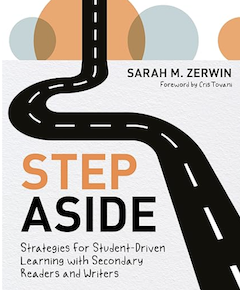Step Aside: Strategies for Student-Driven Learning with Secondary Readers and Writers
By Sarah M. Zerwin
(Routledge, 2025 – Learn more)
Reviewed by Kathee Lamberies
 As teachers, we are always looking for ways to engage our students more with reading and writing and to encourage them to be more independent learners.
As teachers, we are always looking for ways to engage our students more with reading and writing and to encourage them to be more independent learners.
This book intrigued me in my coaching role, as we are in our second year of a new ELA curriculum in 5th-7th grade, and our first year in grades 8th-12th.
Step Aside did not disappoint! This book is full of ideas for secondary teachers to build a classroom that supports and encourages students to become involved, engaged, and in control of their learning of reading and writing.
The book’s chapters include:
 Chapter 1 – Introduction
Chapter 1 – Introduction
Chapter 2 – Invite Students to Drive as Readers
Chapter 3 – Invite Students to Drive as Writers
Chapter 4 – Invite Students to Drive the Conversation in the Classroom
Chapter 5 – Invite Students to Drive Assessment and Grading
Chapter 6 – Design the Classroom Space to Support Student-Driven Learning
Chapter 7 – Student-Driven Learning Makes Our Work More Sustainable
In Chapter 1 the author introduces us to the Three Step Meaning Making Process. She says step one is to start small, step two is to seek connections, and step three is to take action. Ms. Zerwin provides full color, easy to read charts to illustrate her suggested steps as well.
Step one includes original thought annotations for reading, writer’s memos for writing, and conversation prep for talking. Step two has rambling thoughts for reading, mentor text study for writing, and small group conversation for talk strategies, and step three has suggested ways to take action for reading, to make a plan for revision for writing, and whole class conversation for talk strategies.
In Chapter 2 Zerwin begins to lay the foundation for the small steps for reading. She invites students to the first step in making meaning of the text they’re reading by using sentence starters, “I noticed… and I think…” – the key again being to start small. Students annotate questions, and then use these annotations to explore further with rambling thoughts in their writing journals. The final step is to decide how to present their ideas.
Chapter 3 explores writing using the same 3-step meaning-making process as Chapter 2. Step 1 has students answering the magic question, “If you were going to keep working on this, what would you focus on?” In Step 2 they study mentor texts for craft and to strengthen a piece of writing Step 3 focuses on cleaning up mechanics and finalizing a piece of writing.
Inviting Students to Drive the Conversation in the Classroom is the focus of Chapter 4. Students use their annotations and rambling thoughts to come up with talking points. Step 2 involves small group conversations used as a bridge to a formal whole-class discussion where students come up with finalized talking points, and Step 3 is the whole-class discussion, sharing work with the entire group.
Assessment and grading are the highlights of Chapter 5. (The elements discussed in this chapter may be controversial to some, especially those who have strictly enforced grading practices.) Zerwin states how to articulate learning progressions for each of the learning goals and to create must do’s for students for grades.
Students set goals, self-evaluate and then grade themselves based on checklists of content goals and learning behaviors. The author encourages use of descriptive rubrics to show students what complete work means, and she provides many full-color examples and checklists. She says “the goal is independence.”
Chapter 6 talks about designing classroom space to support student-driven learning. This chapter includes keeping a weekly routine and inviting students to practice the same strategies over and over so the work becomes internalized. Again, she offers charts and examples to help educators incorporate this into their classrooms.
Zerwin makes a great point about expectations, explaining how she introduces each routine, policy, and procedure as it becomes relevant in class. I found that to make a lot of sense, as opposed to giving students all of the policies and procedures on the first day and expecting them to remember every one. She reviews seating charts and gives community building ideas as well.
In the final chapter Zerwin discusses how student-driven learning saves teachers time in their planning, preparing, responding to student work, and data management.
I thoroughly enjoyed Step Aside and am planning on using this book for a book study with our secondary teachers over the summer. I believe Zerwin’s methods will encourage students to see reading and writing in a different way and feel more ownership of their work. They will also feel more comfortable discussing their reading and writing and providing feedback to others. I highly recommend Step Aside to secondary ELA teachers!
Kathee Lamberies is a 5-8 Instructional Coach for Roscommon Area Public Schools. Now in her 22nd year in education, she has taught 1st, 2nd, 4th, 5th, 6th, and 7th grades, and has been a coach for the past 3 years. In the 2022-2023 school year she was the Michigan Region 2 Teacher of the Year. She belongs to the Michigan Reading Association and the International Literacy Association. She lives on Otsego Lake in Gaylord, Michigan with her husband Mark and their one-year-old Pomeranian, Pippa.


